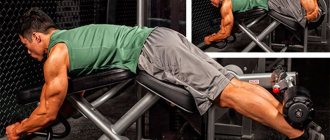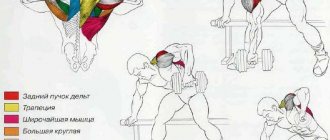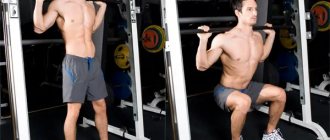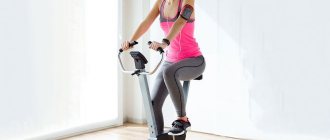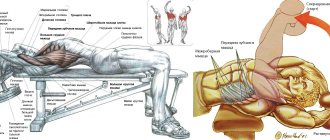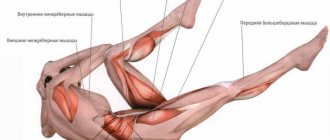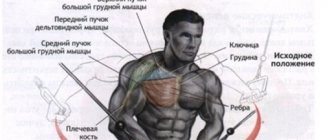Execution options
There are 7 implementation options in total, and although they have the same principle, there are still significant differences:
Classic version: standing barbell chest press
With this performance, all muscle groups receive a higher load than when performed in a sitting position. Also, from the point of view of unloading the lumbar region, this option would be preferable.
From the chest while sitting
It is better to master the military press from a standing position, and after gaining experience, you can move on to the seated version, which allows you to work out the shoulder girdle more efficiently.
Standing Dumbbell Chest Press
When performing an exercise with dumbbells, a large number of small muscles are used to maintain balance and control the direction of the stroke. It becomes possible to work with your hands alternately, which means it’s better to concentrate on each muscle.
From the chest while sitting
Working with dumbbells also allows you to use different weights for different arms, if, for example, one shoulder is more developed than the other and the asymmetry needs to be corrected.
From behind the head while standing
Allows you to diversify the load on the deltas by shifting the emphasis from the front beams to the middle ones. So the best choice is to include both variations in your program: both the chest press and the overhead press.
From behind the head while sitting
As in all previous versions, from a sitting position the stabilizing muscles are almost completely switched off from work. This makes it possible to lift heavier weights for work than in a standing position.
Military press on the Smith machine
Well suited for beginners who are just starting to master this exercise. What's good about this option? The fact is that, thanks to a special device, the barbell has only one axis of mobility, which allows you not to monitor the balance of the body, but to focus on technique.
Studies have been conducted on the distribution of load efficiency for a one-repetition maximum (this is the maximum weight that can be lifted at one time, without violating the technique of performing the exercise):
Sitting/standing position
| barbell: rear delta | dumbbells: rear delta | dumbbells: biceps | dumbbells: front delt | stay: triceps |
| standing press + 25% | standing press + 24% | standing press + 23% | standing press + 8% | standing press + 20% |
Press technique and options
There are three main variations of the military press:
- standing barbells;
- sitting barbells;
- dumbbells while sitting.
In addition to them, standing dumbbell presses and vertical presses in the Smith machine are possible. Whichever option you choose, the main principle of the exercise is to perform the movement in the vertical plane.
Let's look at the general features of the technique of performing a military press without using a Smith machine, which is not difficult to figure out on your own.
After warming up, set the working weight, then take the starting position. To perform a seated press, you need to sit on a bench with a strictly vertical back. The projectile should be taken with an overhand grip.
When using a barbell, we recommend a medium grip—slightly wider than shoulder-width apart—to give an equally serious load to both the shoulders and triceps. A narrow grip puts more stress on your arms, while a wide grip puts more stress on your shoulders.
Place the dumbbells slightly above your shoulders, bending your elbows. Place the barbell on your upper chest (collarbone).
Before doing the standing press, place your feet shoulder-width apart, feet parallel to each other, and bend your knees just a little for shock absorption.
Keep your head straight, without tilting back, as in this case you risk losing your balance and falling (if standing). Look only forward, without raising or lowering your eyes. It’s good if you have the opportunity to do a military press in front of a mirror: it’s so convenient to control the technique.
Important! If, before taking the starting position, you do not remove the barbell from the racks, but lift it from the floor, do not forget to crouch and bend over to lift the apparatus, making a slight bend in the lower back. If neglected, there is a high risk of damaging the spine and/or pulling the long back muscle. In addition, to achieve the desired results in the military press, careful training on the back, pumping up the abs and buttocks is necessary. You cannot relax these muscles during a military press, especially while standing, otherwise there is a high risk of injury to the spine or lower back.
Remember also about proper breathing during the exercise: the upward movement of the projectile is performed while exhaling, returning to the starting position is a deep breath.
Having lifted the projectile, hold it above your head for about 2 seconds, straining your deltoids, then return to the starting position. The return is performed in a smooth motion to avoid injury and/or loss of balance. The lifting is also not done too abruptly, completely controlling the movement of the projectile and the work of the muscles.
When the exercise is completed, all that remains is to return the apparatus - a barbell or dumbbells - to its place. If the barbell needs to be placed on the floor, squat down, holding it on your chest, then gently bend your torso, barely arching at the waist, as when lifting, and lower the iron.
Seated barbell press
We recommend the military bench press with a barbell to bodybuilders who are experiencing temporary back problems.
You can do a seated military press correctly by sitting on a bench with a strictly vertical backrest. If it is installed with a backward tilt, you will inevitably perform another exercise in which you will put most of the load not on the deltoids, but on the pectoralis major muscles. This also applies to the use of a Smith machine for bench presses.
Standing barbell press
When performing a standing chest press, you need to pay close attention to movement technique and safety measures:
- Keep your back straight. If a bodybuilder hunches or leans back, the spine can be easily injured.
- Do not tilt your head and do not look up, following the projectile with your eyes, or down.
- When lifting the barbell, strain your abs more; when lowering, do not completely relax either it or the long back muscles that hold the spine in the correct (straight) position.
- Plant your feet firmly on the floor, keeping them in line with your shoulders. You shouldn't do a split leg exercise - you're doing a standing press with a barbell, not a jerk.
Now that we've dealt with the barbell, it remains to take a closer look at dumbbell presses.
Seated dumbbell press
The press of heavy dumbbells in a sitting position, from the point of view of gaining excellent muscle mass, is in no way inferior to the classic standing barbell press. The only drawback of dumbbells is that most bodybuilding gyms have equipment with a wide range of weights, mostly 5 kilograms. This does not allow you to increase the load smoothly - by 1-1.25 kg. When exercising with a barbell, it is gradually easier to lift the working weight, since light weight plates (usually 1.25 and 0.25 kg) are available in gyms.
The exercise with dumbbells is done as follows:
- Dumbbells should be held in much the same way as a barbell, with your palms facing forward. Straighten your chest and shoulders, moving them back. Turn your elbows out to the sides.
- Raise the apparatus vertically, making a wide arc with your elbows.
- At the top point, straighten your elbows and raise your shoulders.
- Then carefully return the dumbbells to their original position along a similar path.
The standing dumbbell press is done in a similar way, only taking into account the specifics of lifting the barbell from the same position.
What training program allows you to increase your bench press?
The proposed system is based on two options for classes. It is recommended to perform at least two workouts weekly. This is the optimal scheme. If recovery is fairly quick, you can devote up to four days a week to exercise. It all depends on the individual characteristics of the athlete’s body.
The first step towards improving your bench press performance is to determine your maximum. In other words, a bodybuilder needs to find his limit, that is, his record. This indicator becomes the main starting point for drawing up an individual training system.
To fully concentrate on the task at hand, you should focus only on the main task. Therefore, in the training program under consideration, pumping the lower body is completely excluded, and all emphasis is placed only on the upper body. To keep your leg muscles in good tone, it’s enough just to do squat warm-up exercises at the beginning of training or in any free time when you have it.
Now let's talk about the cons
The military bench press combines two serious disadvantages:
- Danger of injury (muscles and joints can be damaged).
- Risk of falling and dropping the barbell (especially when the technique is incorrect).
The fact is that the overhead press involves movement to dampen the inertia of the descending projectile. This occurs by bending the knees and slightly tilting the pelvis from its original position.
If you perform a standing press with straight legs, there will be no shock absorption, and the shock will be absorbed due to the elasticity of the articular cartilage. This means that the joints of the knees, pelvis, spine, and ankles will receive a harmful load. All this can be easily achieved if you do the military press with straight legs (that is, with your knees “locked”).
Another risk is increased stress on the lower back. Therefore, it is recommended to perform the exercise with a special athletic belt. If for some reason you have osteochondrosis of the lumbar spine, and the doctor recommended an orthopedic belt, wear it during approaches. This will reduce the degree of compression of the spine.
The most ridiculous thing that can happen is the barbell falling or being thrown to the floor. This can happen for several reasons: you took on a lot of weight, you are not an experienced athlete. For athletes with little experience, we strongly recommend that you practice the technique of the exercise before increasing the working weights.
Also at risk are the shoulder muscles and shoulder joints. Under no circumstances should you begin performing the military press without thorough pre-warming.
Standards for candidates for master of sports in bench press
Competitions in this type of powerlifting are held according to the following rules:
- The buttocks and shoulders are completely adjacent to the bench, the legs are on a platform or footrest, the head is not fixed.
- The number of assistants for backup is 2-4 people. The participant may ask for help removing the apparatus from the racks.
- The bar is placed with straightened arms, not on the chest.
- Grip width: no more than 81 centimeters (length indicated by notches). If an athlete grasps the bar differently, he must inform the judges about this.
- After removing the barbell, the athlete lowers it onto the chest and presses it up at the judge’s command.
- After lifting the beam, the athlete must secure it with straightened arms. After fixation, plus the judge’s commands, it will be possible to lower the projectile onto the rack.
- All speakers take care of their health independently. The presence of doping and other prohibited substances is unacceptable.
Reasons why a performance may not be counted:
Weight selection
To choose a weight bench tailored to its profile, you need to pay attention to several elements, such as the strength of the bench and its comfort, its additional components, the inclination of the backrest, etc. Everything will depend on the overall purpose and intensity of use, as well as the care provided to the consumer
Multifunctional benches are usually offered for domestic use at home. In a team environment, single-tasking equipment is preferred.
Adjustment pins, rotation axes are often checked by elements when they are used in the community. This simple model allows you to perform benches, work with dumbbells and therefore work with the torso or without material to work the abdominals. There are no adjustments, so it is often used to find a position where one part of the body will be locked in order to mobilize another to work safely without compensating or risking false movement.
- Failure to comply with the referee's commands.
- Violations in the starting position. The buttocks, shoulders, and legs are incorrectly positioned or torn off.
- Pushing the weight with the chest, “in the gap,” etc.
- Uneven straightening of the arms during the approach.
- Downward movement of the bar.
- Touching the apparatus or participant by assistants.
- If the assistants do not leave the platform, I block the view, they interfere with the judges.
- If the weightlifter touches the bench or its supports with his feet.
- Any other failure to comply with the rules.
The standards for candidates for master of sports in the bench press are presented in tables, broken down by weight category and gender. For men, the minimum weight is 52 kilograms, and the maximum is 140 and above. Accordingly, the bar will be from 82.5 to 162.5 kg. For women category 44 - over 90 kg, weight for squeezing 40 - 80. These are the requirements of the International Powerlifting Federation. All data is presented in tables.
Weight bench with leftovers
This is very often a flat bench on which fixed lights are installed, adjustable in height, allowing you to work with developed lying persons. This is more of a denomination regulating the indicator of bars than a real connection with the Olympic world. There are also options with inclining benches: flat, inclined, inclined or straight.
Generally, these benches are used with a person who ensures that the one who is practicing and this person, located at the back of the bench, in the event of a final push is too strong to assist the athlete. This person should be in a comfortable and safe position for their back, usually sent to the front bench.
For men:
| Allowable weight | Candidate Master of Sports |
| 52 | 82,5 |
| 56 | 90 |
| 60 | 97,5 |
| 67,5 | 107,5 |
| 75 | 117,5 |
| 82,5 | 127,5 |
| 90 | 132,5 |
| 100 | 140 |
| 110 | 147,5 |
| 125 | 152,5 |
| 140 | 157,5 |
| 140+ | 162,5 |
For women:
Adjustable massage bench
This is a weight bench, the back and seat of which are adjustable for inclination.
Lumbar Weight Bench
As the name suggests, this type of weight bench is designed to work the dorsalis and lumbar muscles. It is included in the reinforcement of the lumbar musculature bench. This table allows the athlete to hang easily from their feet to stretch the spine and promote lengthening of the muscles.
Biceps bench or Larry Scott
As the name suggests, this type of weights is designed to work the biceps. It is usually equipped with a bar. Larry Scott was the first Mr. Olympia. He attributed the roundness and peak of his biceps to his way of dragging them onto the table, which finally earned his name by popularizing it.
| Allowable weight | Candidate Master of Sports |
| 44 | 40 |
| 48 | 45 |
| 52 | 50 |
| 56 | 55 |
| 60 | 57,5 |
| 67,5 | 65 |
| 75 | 70 |
| 82,5 | 75 |
Military standing barbell press - classic version
Do some warm-up exercises before performing. Next, follow the technique.
Initial position:
- Standing, feet shoulder-width apart.
- Grasp the barbell with an overhand grip, hands also shoulder-width apart.
- Remove the barbell from the rack so that your chest and shoulders are under the bar.
- Step back to a comfortable distance, straighten your back, bend your knees slightly.
Technique:
- With a precise movement, press the bar up, straighten your arms as much as possible.
- Gently lower the projectile to chest level. Don't use your chest as support.
- Do the required number of repetitions.
- Go to the rack, return the bar to its place. Or lower it to the floor.
Recommendations:
Watch your breathing. The projectile reaches the top position while exhaling. It should be lowered downwards while inhaling slowly. While performing variations, the load on one or another muscle group increases.
Power cycle from power-fitness.ru
And now more about the cycle itself. My strength cycle is designed for 1 month of training, or more precisely for 3 weeks of 3 workouts plus one workout - walking.
The cycle consists of light-medium-heavy workouts and a walk on the tenth workout. Light-medium-heavy combinations vary all the time. The load also varies all the time in terms of the number of approaches and repetitions. These techniques add an element of novelty to your training. You train the same exercise three times a week, but each workout has nothing in common with the previous one and, as a result, causes a new adaptation of the body, which means your results increase! During the workouts themselves, you most likely won’t even break a sweat, but rest assured, the cycle will work. Checked!
The cycle itself is done in an Excel file. Download it, open it and instead of “110” enter your maximum weight for one repetition in the bench press. Red checkmarks indicate tooltips - hover your mouse over them and they will open.
Click on the picture to enlarge
This is the cycle calculation table. And you have to do it like this
Click on the picture to enlarge
Workout #1: 45% of maximum weight first set for 5 reps, second and third sets 55% for 5 reps, fourth and fifth sets 65% for 5 reps, sixth and seventh sets 75% for 3 reps. Slight deviations of ±5% are possible. Those. if your maximum in the bench press is 100 kg for 1 rep, then you can do it like this 40/5 50/5 60/5 65/5 67.5/5 70/3 75/3 or like this 40/5 50/5 60/ 5 65/5 70/5 75/3 80/3.
This strength cycle is an excellent method to significantly increase strength in exercises such as the bench press, standing press, squats and deadlifts. I typically used these cycles for two exercises at once, such as bench press and squat, or bench press and deadlift. See my training diary for 2007 from 2007.02.12 to 2007.04.10.
Try it and write me your results and your opinion about it. If you like the series, give your friends a link to my website and this article.
PS Currently, natural training and weightlifting are becoming increasingly popular. The successes of Soviet science in methodological developments were the best in the world! Periodization is the key to long-term strength gains! Read Soviet authors on TA.
I’ll finish with the words of the great Soviet weightlifter, two-time Olympic Champion, Honored Master of Sports of the USSR, Honored Trainer of the USSR Arkady Nikitich Vorobyov:
Once again I will emphasize the words of the master:
Good luck with your bench press training!
Hammer shoulder press technique
- Before starting the exercise, the athlete must adjust the machine to his height. The handles of the levers should be located just above the shoulders.
- Feet spread wide for better balance control.
- Elbows point out to the sides.
- The amplitude of the exercise is long.
- While lifting the levers, the athlete exhales; at the peak of the movement at the top there is no pause.
- During the downward movement, inhale. The weight comes down slowly.
What should you strive for?
To become a CCM, you need to master the technique of performing the approach, in this case - the ideal that you need to become.
Technique:
- When, together with an assistant, the athlete has taken the barbell from the racks, before starting the squeeze-up, take a break until the bar begins to stand steadily (hold it above the chest with outstretched arms).
- Then retract your shoulder blades and quickly lay down the projectile without losing control (about 2 seconds).
- Lower to the solar plexus area.
- You should not do it touching the pectoral muscles. It’s better to touch it, and then quickly press the barbell up, or after a pause.
- At the initial stage (the first few centimeters) the weight should move vertically, and the next distance (to the extreme top position) the bar moves towards the face.
- Then you can squeeze straight (from the lowest position - vertically), or along a steep diagonal line to the collarbones.
- During the upward movement, the athlete should keep his forearms as perpendicular to the floor as possible. Elbows and wrists in one line.
- The lift should be symmetrical. The sports bar must not be tilted to the sides.
- Having secured the crossbar at the top, you need a pause. The projectile is between the middle of the chest and the collarbones. Elbows are completely straight.
- Then – a pause, the bar – in a motionless state; squeezing the shoulder blades and smoothly lowering the bar to the desired point. It’s better to inhale at the top, hold the air when lowering, and exhale when going up.
Based on the above, several recommendations can be formulated:
- It’s worth remembering: the amplitude of movement is inversely proportional to the weight, that is, it should be reduced (increase the grip width, wide - 81 cm, medium - 70-75 cm);
- the more weight, the more muscle required;
- the lifting should take place evenly, slowly, without sudden accelerations of movement.
Military press with dumbbells
This exercise will resemble a dumbbell press, but the difference is that with a regular press, your arms will draw a full circle across your sides, from the middle of your shoulder to the top of your head. In the military dumbbell press version, the movement will be performed more in front of you, along a trajectory similar to lifting a barbell.
- Take a standing or sitting position, take dumbbells in your hands.
- Place your hands on the sides of the shoulders, closer to the front deltoid, slightly extend them in front of the body, palms facing forward.
- As you exhale, press the dumbbells up, do not spread them out to the sides , as when pressing dumbbells. Try to continue moving in the same plane from the starting point. Thus, the load will be felt more in the front deltas.
- Extend your elbows fully, bringing the dumbbells together overhead.
- As you inhale, slowly return the dumbbells to your shoulders.
Bench press exercise description
The bench press is a basic free weight exercise. In bodybuilding, it is often used to develop the triceps, pectoral muscles and anterior deltoid muscle. In powerlifting, along with deadlifts and squats, it is one of the main disciplines, but the load is given to the triceps, anterior deltoids and latissimus dorsi, with almost no involvement of the pectoral muscles.
In this section of the site, the bench press video is accompanied by detailed information not only on how to do the bench press, but also contains useful tips.
When performing the bench press, your program can be varied. Varying the exercise technique in bodybuilding allows you to focus on different muscles. When performing a bench press with a narrow grip, the triceps and inner pectoral muscles are loaded. Lowering the bar to the upper, middle and lower parts of the chest avoids “stagnation” in muscle growth. Bench press on a bench with an incline - head above feet - works the upper chest, in the opposite position - the lower. When performing a bench press with dumbbells, the weight at the bottom point can be lowered significantly lower than when using a barbell. When pressing dumbbells, you can also change the trajectory of movement, bring the dumbbells together at the top point, squeeze the dumbbells parallel to each other - all this allows you to use new muscle bundles and change the load. On the Smith machine you can perform this exercise without insurance, but the machine itself significantly limits the range of motion. Safety net is needed when using heavy weights.
When performing the bench press exercise, technique is extremely important. Never sacrifice technique for weight. Proper bench press training is especially important for those who would like to bench press competitively. For competitions in performing the bench press exercise, the standards vary, but there are some basic conditions for performing this exercise:
- although the grip on the barbell is individual, a triceps press with a grip slightly wider than average is better suited for strength training;
- your legs should be spread wide apart and resting on the floor; lifting your feet off the platform and moving them is strictly prohibited at any competition;
- The larger the chest bridge is (the buttocks touch the bench, the back bends as much as possible, the shoulder blades and the back of the head rest against the bench), the smaller the range of motion of the barbell will be, which will allow you to gain extra pounds. Due to this deflection, the sacral region and long back muscles are effectively loaded;
- try to remove the bar yourself; to do this, the height of the racks must be adjusted;
- when lowering the barbell, inhale and press your elbows towards your body - practice shows that this gives better results than elbows spread out to the sides. The elbows pressed to the body allow you to load the front deltoids, triceps and latissimus dorsi muscles. With splayed elbows, it is better to perform chest presses and pump up your chest.
- When performing a triceps press, you need to lower the barbell to the solar plexus area. At this time, it is better to bring your shoulder blades together, bending along and across the bench. This will reduce the extra distance to the bar and result in gains in extra pounds of weight and strength.
- do not bend your hands; it is better to bandage your wrists with elastic bandages to avoid ligament injuries.
- Once you lower the barbell, stop it without pressing it into your chest. Don’t do bounces - in this case you end up with a fundamentally new exercise, the bench press. Try to hold the barbell with the strength of your hands, sharply squeeze it along the same trajectory as you lowered it (not in a straight line, but slightly in an arc).
Find good health and an attractive body thanks to our bodyclub.pro system
Also see other exercises for the pectoral muscles:
| Exercise | Projectile | Muscle group | Muscles involved | Popularity | Rating |
| Push-ups (narrow hand placement) | Using body weight | Breast | Pectoral muscles | 337931 | 3768 |
| Push-ups (Indian press) | Using body weight | Breast | Pectoral muscles | 214733 | 400 |
| Push-ups (wide arms) | Using body weight | Breast | Pectoral muscles | 203357 | 1041 |
| Push ups | Using body weight | Breast | Pectoral muscles | 201953 | 1216 |
| Lateral raises with dumbbells | Dumbbells | Breast | Pectoral muscles | 169054 | 1397 |
Copyright for this material belongs to the Fitness 96 portal. When reprinting, a link to the site www.fitness96.ru is required. Comments:
Muscles involved
Professionals prefer to begin training this exercise after the rear deltoids have been warmed up with light weight swing exercises.
If the exercise is performed correctly, the load is distributed as follows: deltoids, triceps, chest, back.
- The main load is placed on the middle and anterior bundles of the deltoid muscles.
- The secondary load falls on the upper back and upper chest muscles.
- Indirect load affects the triceps and posterior deltoid muscles.
- The work includes the trapezius muscles, gluteal muscles, as well as the abs and thighs.
Regularly performing the military press allows you to get expressive shoulders and significantly expand your deltoids.
For athletes involved in weightlifting, this exercise makes it possible to increase explosive strength and improve the mobility of the joints of the shoulder girdle.
Changing body position and grip width provides load on various parts of the shoulder girdle. If you strictly follow the execution technique, you can achieve impressive results in a fairly short period of time.
What to pay special attention to
This is a barbell press, not a clean and jerk.
Often, beginning bodybuilders, mastering this exercise on their own, confuse its execution technique with pushing a barbell from the chest in a standing position. The fact is that the starting position is the same in both cases, and the push allows you to lift more weight with less effort. The upward movement of the barbell is carried out due to the extension of the legs, which gives it inertia, and then it is pressed to the top position by the force of the arms. As you can see, this is fundamentally different from the military press, where all the work is done by the delta.
Eliminate unnecessary movements
During execution, it is important to avoid unnecessary or incorrect movements, because
this can lead to injury or “eat up” up to 90% of the effectiveness of the exercise. Key points to consider:
- The bar should not linger in the upper or lower position: as soon as the rise ends, the descent immediately begins.
- Don't try to push the projectile with your legs or chest at the beginning of the movement - this will steal the payload from your shoulders.
- Your gaze is directed strictly forward; you should not move your head while following the bar with your gaze, as this will cause you to bend your back backwards and overload your spine.
We monitor the position of the body, arms and legs
There should not be a situation where one leg is in front and the other is behind. This is done to ensure that the spine is balanced and there are no distortions. After all, when working with heavy weight, any distortion can immediately turn into injury.
The next point is body position. Under no circumstances should you lean back. As a matter of fact, this is why we are looking forward, so that such a desire does not arise. Often people lift a very heavy weight, and in order to help themselves with their chest, simplifying the exercise, they lean back. Always remember that the correct movement is performed by the deltoids, not the chest.
The wrists and forearm should be perpendicular to the floor and remain in this position throughout the entire range of motion. To do this correctly, you will have to take exactly the grip that was discussed above - shoulder-width apart. Otherwise, breaking tension will be created in the shoulder joints.
Work with “your” weight, don’t force it
You should increase the weight gradually, making sure that you can do the bench press technically correctly, without mistakes or unnecessary movements. There is no need to try to impress or prove something - start with light weights and achieve the correct technique, because in this exercise it plays a key role. Remember that your goal is beautiful broad shoulders and good health, not setting world records.
Don't neglect warming up
In any exercises with heavy equipment, you should never immediately take on the working weight, especially if your shoulders are involved in them, because they can very easily get a painful and very unpleasant tear.
- start your workout with cardio exercise, for example, with a short jog or on a stationary bike;
- perform bench presses with an empty bar or dumbbells 10-15 times;
- take a weight that is 30-35% of the working weight, do 15 repetitions;
- increase the load to 50% and perform 4-5 presses;
- Now your deltoids are warmed up enough and ready to move on to serious work - you can start doing working weights.
Common mistakes
Confusion in technology
Often, beginners confuse the military press with the barbell overhead press (standing or seated). The key difference is that with the military press, the starting position places the barbell on the upper chest, while with the overhead press it rests on the shoulders near the back of the neck.
Many bodybuilding coaches do not give their trainees overhead presses for two reasons. The first is that the movement is less natural than lifting weights from the chest, and therefore carries a higher risk of injury to the shoulder joints. The second is that when lifting from behind the head, the amplitude of movement is smaller, which means that the benefit for the trainee is less.
Contraindications
The standing press is contraindicated for lovers of a healthy lifestyle who suffer from:
- serious problems with the spine;
- diseases of the joints of the arms and shoulders themselves;
- pathologies of the cardiovascular system.
These athletes should replace the barbell chest press with less strenuous exercises for the deltoids and triceps.
Extra movements
You should not lift the barbell up while making movements with your lower back and legs, which are called cheating. They increase the risk of injury and reduce the effect on the “target” muscles.
Show real soldier discipline during the military press. Let the movement happen as expected.
What to do when there are certain problems
Unpleasant pain
Most often they occur in the shoulders or wrists, and sometimes the triceps may hurt.
- A common mistake that leads to pain in the wrist is bending it towards you when performing an exercise, while the correct position is strictly perpendicular to the floor. But, if this does happen, an elastic bandage will help you.
- If the delta is pulled, recovery may be delayed, so it is recommended to completely eliminate the load on this muscle and seek help from a doctor. The same goes for the triceps - give it a rest.
Problems maintaining balance
If in normal life your coordination is fine, but when you start doing the military press you have problems, then most likely you simply took on too much weight. At the same time, it is difficult to catch the balance point, you begin to be “led” and sometimes you just have to throw the barbell on the floor. There's nothing wrong with that, you're just not trained enough for that weight yet.
Lack of flexibility
It happens that people have some stiffness in the shoulder girdle. In this case, the correct execution technique becomes unnatural for them. You should never go against your own body, it will not lead to anything good. To increase shoulder mobility, try yoga, stretching, or exercise therapy.
Back and lower back pain
If you tried to work with heavy weights without raising your technique to the proper level, you may experience lower back pain. Therefore, never force the load, always monitor your technique and use a special athletic belt when doing bench presses. But, if it’s too late for useful advice and pain is already present, wear an orthopedic belt for the lower back.
If you have weak back muscles, standing barbell presses can cause pain. In this case, it is recommended to train the latissimus dorsi, trapezius and rhomboid muscles separately, and do the military press while sitting on a bench with a backrest.
How often to load the delta
The stronger the load, the more time the muscles need to recover. Overloading a muscle group will only lead to their overtraining, and you will be forced to interrupt your activities until the body is completely restored. If you give shock loads to the deltas, then next time it is recommended to work with them no earlier than after 10-12 days. In a normal training regime, this interval is 7 days.
In the following video you can watch the technique of performing the military press while standing and sitting:
If you do the same exercises and do not increase the weight, over time this will lead to the fact that the muscles will stop growing and you will simply maintain their tone. That’s why the military press, which has as many as 7 options, is so good. You have ample opportunities to combine loads and develop the deltoid muscles: when the weight limit in the standing press is reached, you can move on to the seated version.
More isolated work on the shoulder girdle, also with increased weight, will allow you to make a breakthrough and continue to increase working weight, and therefore build muscle mass. Remember that regular practice is very important. If you work technically correctly and without overloading, you will immediately feel how you become much stronger, and your shoulders widen and fill with mass.
What else to read:
Benefits of the Military Press
To begin with, this movement did not come from the training of US Navy SEALs, as is commonly written everywhere in RuNet, but as a traditional element of training weightlifters. The SEALs really do it, since a good military press will help both throw a bag onto a support and pull out a wounded comrade if something happens. But it is impossible to say for sure who “invented” the exercise. Lifting weights overhead was known to the ancient Greeks, judging by the frescoes, and has always been considered a good developmental exercise.
The military press allows you to develop not so much the strength of the shoulders and triceps themselves, but rather the synergy in the movement of the legs, body, and arms. In addition, it allows you to increase the strength of the entire upper body precisely due to stabilization. It also serves as an excellent special-preparatory movement for a good half of bench press exercises, and partly for strength-speed exercises, such as clean and jerks.
All this has led to the high popularity of the exercise in modern times. In fact, it was not powerlifting or bodybuilding that “infected” the masses with this movement, but CrossFit. When many people came to CrossFit boxes in order to become as cool as those guys in the video, they discovered that they lacked not only strength indicators, but also endurance, as well as banal amplitude in the joints. The military press helps you develop all the necessary movements in CrossFit, from throwing medicine balls from the chest to weightlifting clean and jerks. It also serves to stabilize the shoulder joint in movements performed on the bar.
The military press was also respected by old school bodybuilders. Most of them trained in one way or another with coaches who came from Soviet weightlifting. In this form, lifting weights overhead is a basic movement.
The benefits of the exercise do not end with its applied significance for various disciplines. Being basic, it involves most of the muscles of the upper body. This allows the athlete to effectively build muscle mass and activate neuromuscular connections, as a result, the gain will actually happen faster than if you do only isolation in the gym.
In addition to the shoulders, the movement works great on the triceps. It allows you to change the shape of your hands. Therefore, the military bench press is often given to girls who want to quickly tone their arms, no matter how paradoxical it may sound.
With the correct technique, movement serves as an excellent prevention of problems arising due to insufficiently active blood circulation in the cervical-collar area. A number of sources mention that the military bench press is a prevention of trapezius hypertonicity in security forces and headaches associated with muscle spasms.
Important: all the benefits of the military press are revealed only when the exercise is performed using the correct technique
It's the STANDING PRESS, baby!
Why is this exercise so popular?
Everyone wants to have broad and beautiful shoulders, so they often ask their trainers or look for some special techniques for their development. But in reality everything turns out to be much simpler! The deltoid muscle can perform two functions: “push” and “pull”, so to develop large, broad shoulders, it is enough to perform one exercise in each direction.
The military press in this sense is the most effective option for developing the pushing function of the shoulder; no other exercise can develop the delta as quickly as this. Also, due to the specifics of the execution (which will be discussed below), the triceps receives an absolutely unique load, which ensures an effective increase in its strength and mass. In addition, the body begins to actively produce stress hormones, which significantly enhance the effectiveness of the workout.
Presses on machines
Suitable as an analogue of the military press for beginners, as well as for multi-repetition training for more experienced athletes with the goal of “finishing off” the deltoids at the end of the workout.
Exercises on simulators are performed to isolate the deltoid muscles. The Smith machine is popular among athletes. On a rack of a unique configuration, the bar of the bar moves exclusively up and down. When performing bench presses on the machine, your arms do not straighten completely. The number of repetitions on the simulator reaches 8-12.
The Hammer simulator allows you to distribute the load throughout the entire spine, and not focus it in the lumbar region, as with other types of training in a sitting position. The seat height varies to concentrate on maximum weight or to ideally isolate a specific muscle group. The Hammer machine eliminates lumbar deflection. The range of movement with the elbows strictly fixed in the desired position is anatomically correct.
What equipment should be
Sophisticated yet portable and easy to use! Warranty: 6 months against manufacturing defects. . The goal is to avoid tax evasion. The exception is the United States, which has its own standard. At the start of the year, the French will be required to fulfill their responsibilities to creditors and their employees by quickly settling with their bank. In practice, transactions that do not comply with the new standards will no longer be accepted by banks: daily transactions of companies, such as payroll or payments to suppliers, may be blocked in this case.
Clothes play an important role here. First of all, it prevents the occurrence of injuries.
The following protective measures exist:
- Wristbands (hard elastic bandages) to protect the wrists.
- A shirt (undershirt) prevents injuries to the shoulders and chest.
- Shoes do not play a special role, but should be comfortable and familiar to the athlete.
Warning! Constant use of a T-shirt for training causes weakening of the tendons, and accordingly the risk of injury in competitions greatly increases
It is better to wear it a few weeks before the important stage. Assistance exercises for the bench press should be performed without equipment
There is a lot of controversy among athletes regarding this type of protection, as there have been many accidents while using the shirt. Tip: train with an assistant.
The banking sector's argument is that these standards will allow the timing of bank transfers in Europe and better debtors at the time of withdrawals. It is a practice based on physical exercises in which the athlete lifts his own weight or bar with weighted cast discs at each end. Strength training allows you to develop some or all of the muscles in your body. Practicing bodybuilding also helps you improve your silhouette and keep your body in good shape.
Characteristics of the weight bench
Whether it's indoors or outdoors, initiation into this sport often means having the right weight board. So here are some tips for choosing your device. There are several models of benches equipped with different components.
Standing chest press
This exercise is simply irreplaceable for those who want to develop the muscles of the shoulder girdle, and in addition, increase the overall volume of muscles.
The military press is an extremely productive exercise, which is included in the list of mandatory exercises in the American army.
The weight must be set so that eight to twelve repetitions can be performed. We take the barbell at chest level, point our palms away from ourselves, and place our arms wider than shoulder-width apart.
When lifting the barbell, your shoulders should be pulled back a little, and your chest, on the contrary, should be pushed forward a little, thus maintaining the correct curve of the spine. When lifting the barbell, your arms must be fully straightened. It is not advisable to lower the barbell below the clavicular cavity.
It is important to keep your torso straight, otherwise you will not be able to create normal support for performing the exercise.
You should not carry too much weight, as it can pull you back, which will inevitably lead to loss of balance and even injury. It is important to watch exactly how you hold the barbell. Remember, your thumb must grip the bar securely, otherwise you may drop the barbell.
You need to press the barbell above your head, and in no case, in front of you. From time to time you need to pay attention to the flexibility of the shoulder joints and warm them up properly.
The standing barbell chest press is not suitable for people who have problems with the spine or shoulder girdle. In general, before you start performing this exercise, it would be a good idea to consult a doctor.
Training program to increase bench press results
When you have decided on your own repetition maximum, you can start training.
First training
- 1. Bench press (60% of 1 repetition maximum) – 1 warm-up set + 3 working sets of 5 repetitions – performed at maximum speed, training explosive strength;
- 2a. Close-grip bench press – warm-up set + 3 working reps of 5 reps – we also work in speed mode, strengthening the triceps and inner chest;
- 2b. Standing barbell press – 1 warm-up set + 3 working sets – strengthening the anterior deltoid muscles.
- 3. Wide grip pull-ups - 1 set with only your own weight for 7-8 repetitions, 2 set with additional weights for 6-8 repetitions, and the last set again with your own weight for the maximum number of repetitions.
- 4. Bent-over barbell rows – 2 warm-up sets + 3 working sets of 6-8 reps.
Second training
1. Bench Press – 40% of 1 rep max for 8 reps, 55% for 5 reps, 70%*1, 80%*1, 90%*1, 100%*1, new record.
- 2. French bench press – 2 warm-up + 3 working sets of 8 repetitions;
- 3. Lifting the barbell for biceps – 1 warm-up + 3 working sets of 8 repetitions.
Setting new records and working with maximum weight is necessary only with a partner. It is recommended to work according to the presented program from 16 to 18 weeks, training twice a week.
Recommendations for implementation
- It is very important to control your every movement. Feel your triceps stretch at the bottom and contract as you return to the starting position.
- Throughout the entire execution, keep your hands pressed to your body. There is no need to spread your elbows to the sides. This will shift the emphasis from the triceps to the pectoral muscles.
- Movement occurs only in the elbow joints. There is no need to lower your arms down at the lowest point. So, we will connect the front delta to the movement, which will take on part of the load.
- We lower the barbell down until the biceps and forearms touch each other.
- Do not lower the barbell down until the bar touches the upper part of the pectoral muscles. This technique will not help stretch the triceps further. At the same time, your shoulders will experience more stress.
- Don't turn the exercise into a French press. The barbell is lowered along a vertical path to the upper part of the pectoral muscles.
